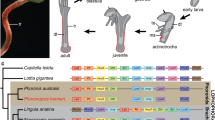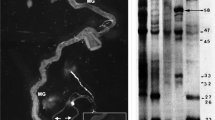Abstract
Heat shock proteins (Hsps) have dual functions, participating in both the stress response and a broad range of developmental processes. At physiological temperatures, it has been demonstrated in deuterostomes (vertebrates) and ecdysozoans (insects) that Hsps are expressed in tissues that are undergoing differentiation and morphogenesis. Here we investigate the developmental expression of Hsp70, Hsp90 and their regulatory transcription factor heat shock transcription factor (HSF) in the marine gastropod Haliotis asinina, a representative of the 3rd major lineage of bilaterian animals, the Lophotrochozoa. HasHsp70, HasHsp90 and HasHSF are maternally expressed in H. asinina and are progressively restricted to the micromere lineage during cleavage. During larval morphogenesis, they are expressed in unique and overlapping patterns in the prototroch, foot, and mantle. Hsp expression peaked in these tissues during periods of cell differentiation and morphogenesis, returning to lower levels after morphogenesis was complete. These patterns of Hsp and HSF expression in H. asinina are akin to those observed in ecdysozoans and deuterostomes, with Hsps being activated in cells and tissues undergoing morphogenesis.





Similar content being viewed by others
References
Angelier N, Moreau N, Rodriguez-Martin ML, Penrad-Mobayed M, Prudhomme C (1996) Does the chaperone heat shock protein hsp70 play a role in the control of developmental processes? Int J Dev Biol 40:521–529
Barlow LA, Truman JW (1992) Patterns of serotonin and SCP immunoreactivity during metamorphosis of the nervous system of the red abalone, Haliotis rufescens. J Neurobiol 23:829–844
Bishop CD, Bates WR, Brandhorst BP (2002) HSP90 function is required for morphogenesis in ascidian and echinoid embryos. Dev Genes Evol 212:70–80
Chen B, Zhong D, Monteiro A (2006) Comparative genomics and evolution of the Hsp90 family of genes across all kingdoms of organisms. BMC Genomics 7:156 DOI 10.1186/1471-2164-7-156
Chou CC, Forouhar F, Yeh YH, Shr HL, Wang C, Hsiao CD (2003) Crystal structure of the C-terminal 10-kDa subdomain of Hsc70. J Biol Chem 278:30311–30316
Counihan RT, McNamara DC, Souter DC, Jebreen EJ, Preston NP, Johnson CR, Degnan BM (2001) Pattern, synchrony and predictability of spawning of the tropical abalone Haliotis asinina from Heron Reef, Australia. Mar Ecol Prog Ser 213:193–202
Crofts DR (1937) The development of Haliotis tuberculata, with special reference to organogenesis during torsion. Philos Trans R Soc Lond B 228:219–285
Csermely P, Schnaider T, Söti C, Prohászka Z, Nardai G (1998) The 90-kDa molecular chaperone family: structure, function and clinical applications. Pharmacol Ther 79:129–168
Degnan BM, Morse DE (1993) Identification of eight homeobox-containing transcripts expressed during larval development and at metamorphosis in the gastropod mollusc Haliotis rufescens. Mol Mar Biol Biotech 2:1–9
Degnan BM, Groppe JC, Morse DE (1995) Chymotrypsin mRNA expression in digestive gland amoebocytes: cell specification occurs prior to metamorphosis and gut morphogenesis in the gastropod, Haliotis rufescens. Roux’s Arch Dev Biol 205:97–101
Dictus WJAG, Damen P (1997) Cell-linage and clonal-contribution map of the trochophore larva of Patella vulgata (Mollusca). Mech Dev 62:213–226
Ding D, Parkhurst SM, Halsell SR, Lipshitz HD (1993) Dynamic Hsp83 RNA localization during Drosophila oogenesis and embryogenesis. Mol Cell Biol 13:3773–3781
D’Sousa SM, Brown IR (1998) Constitutive expression of heat shock proteins Hsp90, Hsc70, Hsp70 and Hsp60 in neural and non-neuronal tissues of the rat during postnatal development. Cell Stress Chaperones 3:188–199
Giebel LB, Dworniczak BP, Bautz EK (1988) Developmental regulation of a constitutively expressed mouse mRNA encoding a 72-kDa heat shock-like protein. Dev Biol 125:200–207
Giusti AF, Hinman VF, Degnan SM, Degnan BM, Morse DE (2000) Expression of a Scr/Hox5 gene in the larval central nervous system of the gastropod Haliotis, a non-segmented spiralian lophotrochozoan. Evol Dev 2:294–302
Goldstone JV, Hamdoun A, Cole BJ, Howard-Ashby M, Nebert DW, Scally M, Dean M, Epel D, Hahn ME, Stegeman JJ (2006) The chemical defensome: environmental sensing and response genes in the Strongylocentrotus purpatus genome. Dev Biol 300:366–384
Gupta RS (1995) Phylogenetic analysis of the 90 kD heat shock family of protein sequences and an examination of the relationship among animals, plants and fungi species. Mol Biol Evol 12:1063–1073
Hejnol A, Martindale MQ, Henry JQ (2007) High-resolution fate map of the snail Crepidula fornicata: the origins of ciliary bands, nervous system, and muscular elements. Dev Biol 305:63–76
Herberts C, Moreau N, Angelier N (1993) Immunolocalization of Hsp70-related proteins constitutively expressed during Xenopus laevis oogenesis and development. Int J Dev Biol 37:397–406
Hofmann GE (2005) Patterns of hsp gene expression in ectothermic marine organisms on small to large biogeographic scales. Integr Comp Biol 45:247–255
Inoue T, Takamura K, Yamae H, Ise N, Kawakami M, Tabuse Y, Miwa J, Yamaguchi Y (2003) Caenorhabditis elegans DAF-21 (Hsp90) is characteristically and predominantly expressed in germline cells: spatial and temporal analysis. Dev Growth Differ 45:369–376
Jackson DJ, Degnan BM (2006) Expressed sequence tag analysis of genes expressed during development of the tropical abalone Haliotis asinina. J Shellfish Res 25:225–232
Jackson DJ, Ellemor N, Degnan BM (2005) Correlating gene expression with larval competence, and the effect of age and parentage on metamorphosis in the tropical abalone Haliotis asinina. Mar Biol 147:681–697
Jebreen EJ, Counihan RC, Fielder DR, Degnan BM (2000) Synchronous oogenesis during the semilunar spawning cycle of the tropical abalone Haliotis asinina. J Shellfish Res 19:845–851
Kato M, Mizuguchi M, Takashima S (1995) Developmental changes of heat shock protein 73 in human brain. Dev Brain Res 86:180–186
Kourtidis A, Drosopolou E, Nikolaidis N, Hatzi VI, Chintiroglou CC, Scouras ZG (2006) Identification of several cytoplasmic Hsp70 genes from the Mediterranean mussel (Mytilus galloprovincialis) and their long-term evolution in Mollusca and Metazoa. J Mol Evol 62:446–459
Lele Z, Hartson SD, Martin CC, Whitesell L, Matts RL, Krone PH (1999) Disruption of zebrafish somite development by pharmacologic inhibition of Hsp90. Dev Biol 201:56–70
Lindquist S (1986) The heat-shock response. Annu Rev Biochem 55:1151–1191
Loones MT, Chang YH, Morange M (2000) The distribution of heat shock proteins in the nervous system of the unstressed mouse embryo suggests a role in neuronal and non-neuronal differentiation. Cell Stress Chaperones 5:291–305
Morimoto RI, Tissieres A, Georgopoulos C (1994) Progress and perspectives on the biology of heat shock proteins and molecular chaperones. In: Morimoto R, Tissières A, Georgopoulis C (eds) The biology of heat shock proteins and molecular chaperones. Cold Spring Harbor Laboratory Press, Cold Spring Harbor, pp 1–30
Morishima N (2005) Control of cell fate by Hsp70: more than an evanescent meeting. J Biochem (Tokyo) 137:449–453
Münster PN, Srethapakdi M, Moasser MM, Rosen N (2001) Inhibition of Heat shock protein 90 function by Ansamycins causes the morphological and functional differentiation of breast cancer cells. Cancer Res 61:2945–2952
Nielsen C (2004) Trochophora larvae: cell-lineages, ciliary bands, and body regions. 1. Annelida and Mollusca. J Exp Zool (Mol Dev Evol) 302B:35–68
Page LR (2006) Modern insights on gastropod development: reevaluation of the evolution of a novel body plan. Integr Comp Biol 46:134–143
Perkins LA, Doctor JS, Zhang K, Stinson L, Perrimon N, Craig EA (1990) Molecular and developmental characterization of the heat shock cognate 4 gene of Drosophila melanogaster. Mol Cell Biol 10:3232–3238
Perret E, Moudjou M, Geraud ML, Derancourt J, Soyer-Gobillard MO, Bornens M (1995) Identification of an HSP70-related protein associated with the centrosome from dinoflagellates to human cells. J Cell Sci 108:711–725
Piano A, Franzillitti S, Tinti F, Fabbri E (2005) Sequencing and expression pattern of inducible heat shock gene products in the European flat oyster, Ostrea edulis. Gene 361:119–126
Pirkkala L, Nykanen P, Sistonen L (2001) Roles of the heat shock transcription factors in regulation of the heat shock response and beyond. FASEB J 15:1118–1131
Pratt WB, Toft DO (1997) Steroid receptor interactions with heat shock protein and immunophilin chaperones. Endocr Rev 18:306–360
Pratt WB, Toft DO (2003) Regulation of signalling protein function and trafficking by the hsp90/hsp70-based chaperone machinery. Exp Biol Med 228:111–133
Queitsch C, Sangster TA, Lindquist S (2002) Hsp90 as a capacitor of phenotypic variation. Nature 417:618–624
Raven CP (1966) Morphogenesis: the analysis of molluscan development. Pergamon, Sydney, pp 127–199
Rensing SA, Maier UG (1994) Phylogenetic analysis of the stress-70 protein family. J Mol Evol 39:80–86
Rubio E, Valenciano AI, Segundo C, Sánches N, de Pablo F, de la Rosa EJ (2002) Programmed cell death in the neurulating embryo is prevented by the chaperone heat shock cognate 70. Eur J Neurosci 15:1646–1654
Rutherford S, Lindquist S (1998) Hsp90 as a capacitor for morphological evolution. Nature 396:336–342
Sass JB, Weinberg ES, Krone PH (1996) Specific localization of zebrafish hsp90a mRNA to myoD-expressing cells suggests a role for hsp90a during normal muscle development. Mech Dev 54:195–204
Sconzo G, Amore G, Capra G, Guidice G, Cascino D, Ghersi G (1997) Identification and characterization of a constitutive hsp75 in sea urchin embryos. Biochem Biophys Res Commun 234:24–29
Serras F, van den Biggelaar JAM (1987) Is a mosaic embryo also a mosaic of communication compartments? Dev Biol 120:132–138
Serras F, Damen P, Dictus WJAG, Notenboom RGE, van den Biggelaar JAM (1989) Communication compartments in the ectoderm of embryos of Patella vulgata. Roux’s Arch Dev Biol 198:191–200
Serras F, Dictus WJAG, van den Biggelaar JAM (1990) Changes in junctional communication associated with cell cycle arrest and differentiation of trochoblasts in embryos of Patella vulgata. Dev Biol 137:207–216
Sriram M, Osipiuk J, Freeman BC, Morimoto RI, Joachimiak A (1997) Human Hsp70 molecular chaperone binds two calcium ions within the ATPase domain. Structure 5:403–414
Swofford DL (1998) PAUP*. Phylogenetic analysis using parsimony (* and other methods). Sinauer, Sunderland
van den Biggelaar JAM (1993) Cleavage pattern in embryos of Haliotis tuberculata (Archaeogastropoda) and gastropod phylogeny. J Morphol 216:121–139
Vanmuylder N, Werry-Huet A, Rooze M, Louryan S (2002) Heat shock protein Hsp86 expression during mouse embryo development, especially in the germ line. Anat Embryol (Berl) 205:301–306
Vega-Núñez E, Peña-Melián A, de la Rosa EJ, de Pablo F (1999) Dynamic restricted expression of the chaperone Hsp70 in early chick development. Mech Dev 82:199–203
Westwood JT, Clos J, Wu C (1991) Stress-induced oligomerization and chromosomal relocalization of heat-shock factor. Nature 353:822–826
Young JC, Moarefi I, Hartl FU (2001) Hsp90: a specialized but essential protein-folding tool. J Cell Biol 154:267–273
Zhao R, Davey M, Hsu C, Kaplanek P, Tong AB, Parsons AB, Krogan N, Cagney G, Mai D, Emili A, Houry W (2005) Navigating the chaperone network: an integrative map of physical and genetic interactions mediated by the Hsp90 chaperone. Cell 120:715–727
Zimmerman JL, Cohill PR (1991) Heat shock and thermotolerance in plant and animal embryogenesis. New Biol 3:637–640
Acknowledgements
The authors thank two anonymous reviewers for their insightful comments. This research was supported from grants from the Australian Research Council to BMD.
Author information
Authors and Affiliations
Corresponding author
Additional information
Communicated by M. Martindale
Electronic supplementary material
Below is the link to the electronic supplementary material.
Fig. S1
HasHsp90 full-length cDNA sequence. The HasHsp90 nucleotide sequence is presented with the conceptual amino acid translation below. ATP interaction domain highlighted in light grey, charged linker underlined once, middle domain in dark grey and dimerisation domain is underlined twice. The stop codon is indicated by a full stop (DOC 32 kb)
Fig. S2
HasHsp70 partial sequence. cDNA fragment from the ATPase and protein interaction domain. The HasHsp70 nucleotide sequence is presented with the conceptual amino acid translation below. Highlighted areas represent conserved sequence motifs of heat inducible Hsp70 identified in Rensing and Maier (1994) and Kourtidis et al. (2006). The numbering is based purely on the fragment and does not relate to the 3′ end of the ORF (DOC 31 kb)
Fig. S3
HasHSF full-length sequence. The nucleotide sequence is presented with the conceptual amino acid translation below. The DNA binding domain is highlighted in light grey and the leucine zipper domains are underlined. The stop codon is indicated by a full stop (DOC 37 kb)
Table S1
Genbank accession numbers for sequences used in phylogenetic analyses (DOC 50 kb)
Rights and permissions
About this article
Cite this article
Gunter, H.M., Degnan, B.M. Developmental expression of Hsp90, Hsp70 and HSF during morphogenesis in the vetigastropod Haliotis asinina . Dev Genes Evol 217, 603–612 (2007). https://doi.org/10.1007/s00427-007-0171-2
Received:
Accepted:
Published:
Issue Date:
DOI: https://doi.org/10.1007/s00427-007-0171-2




